
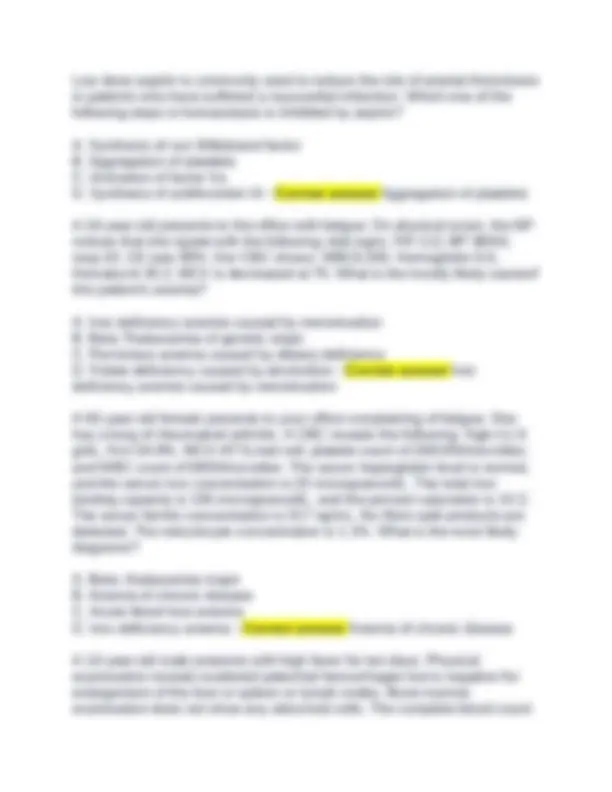
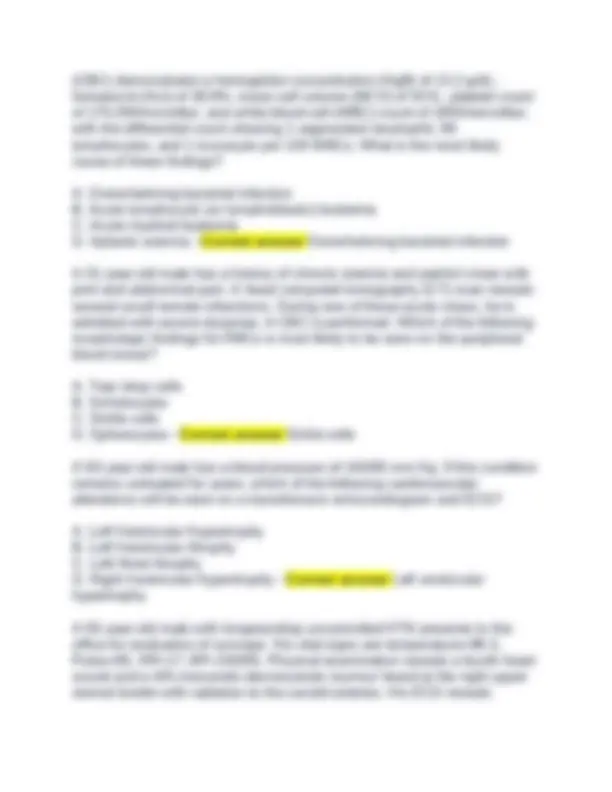

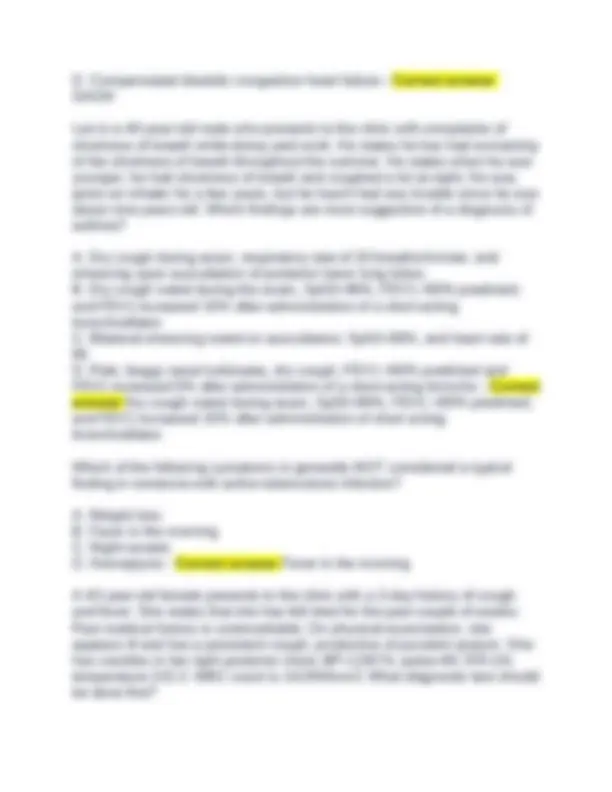
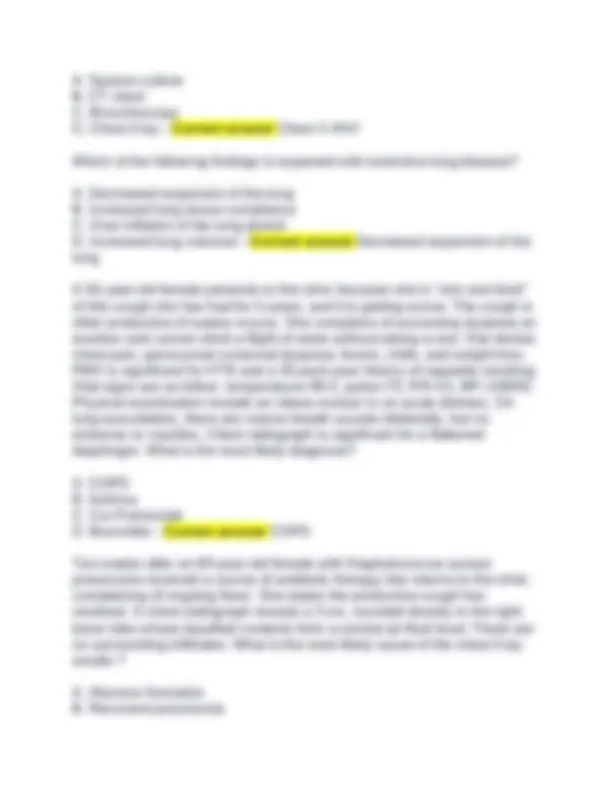
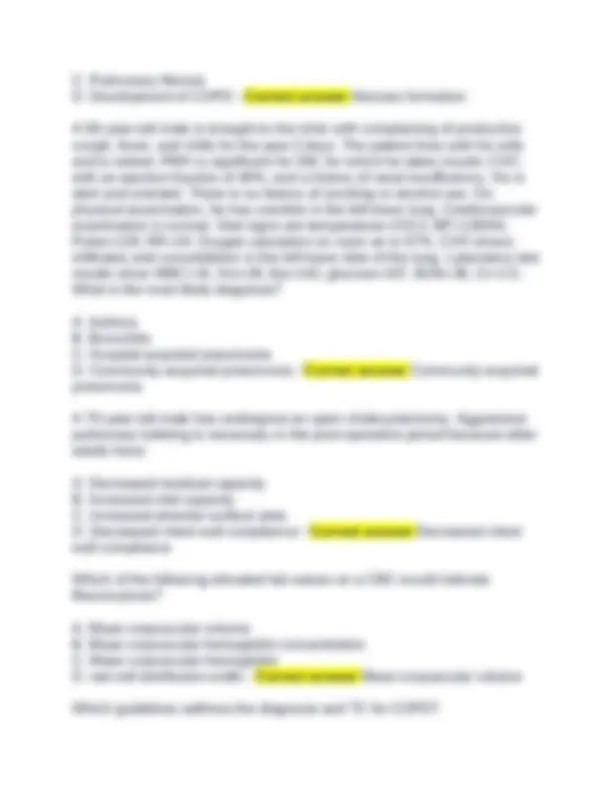
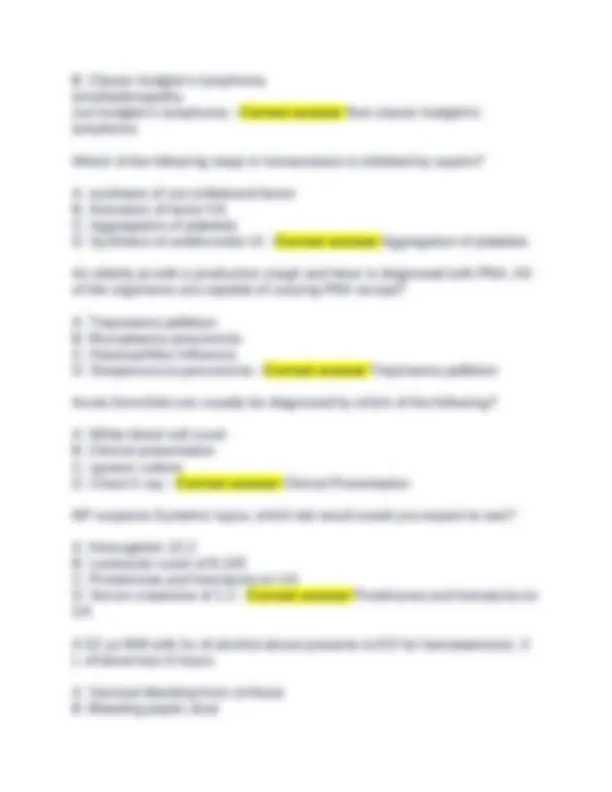
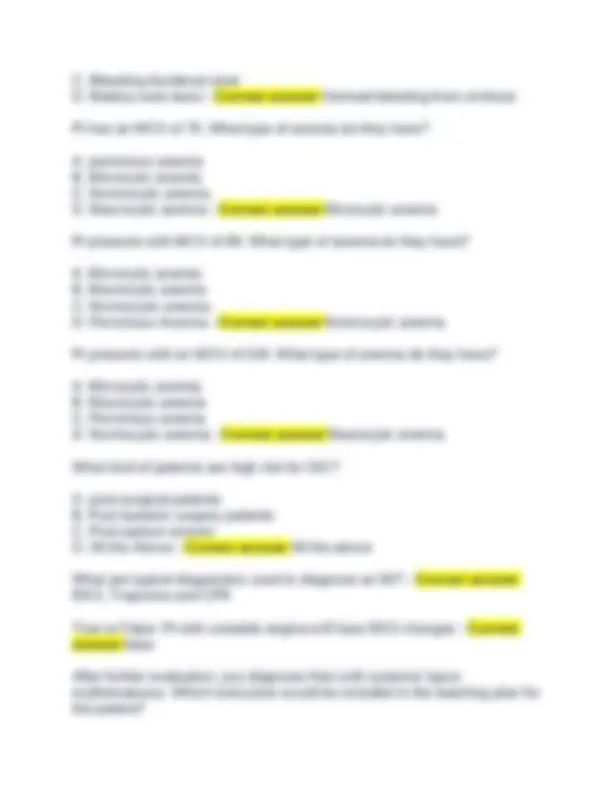
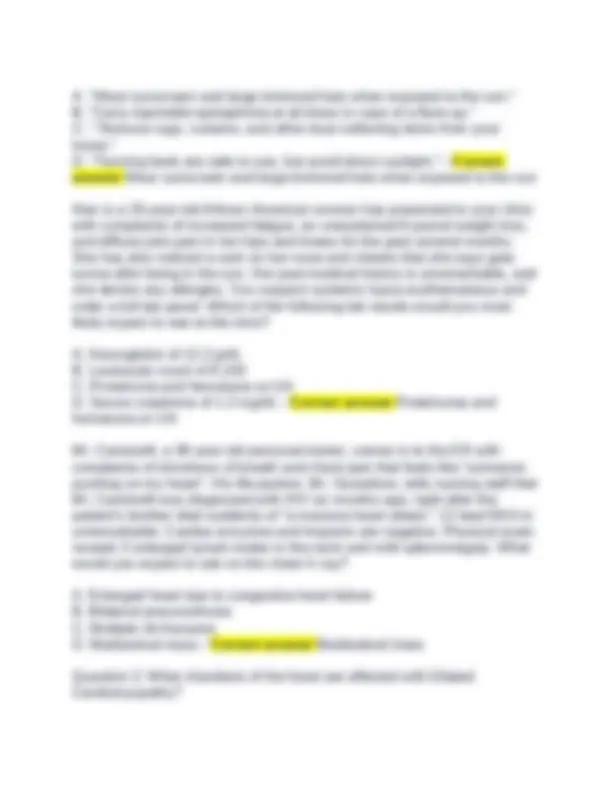
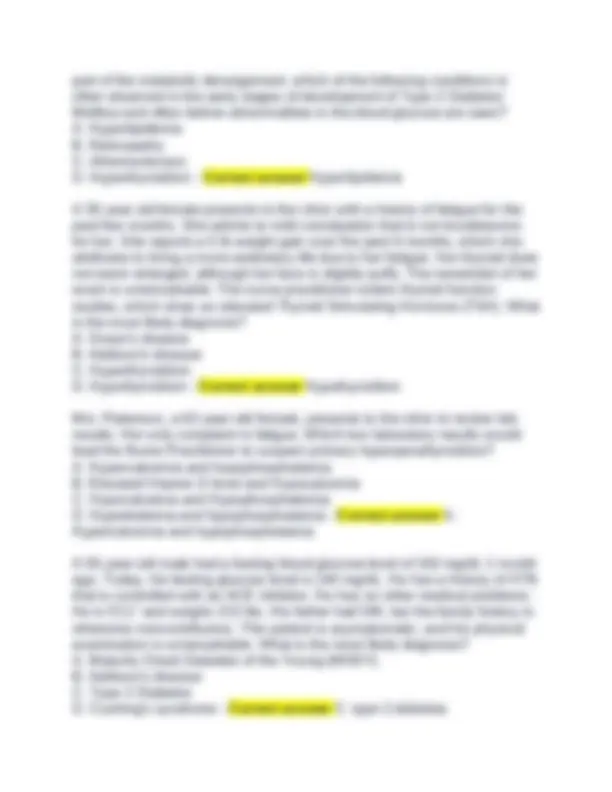
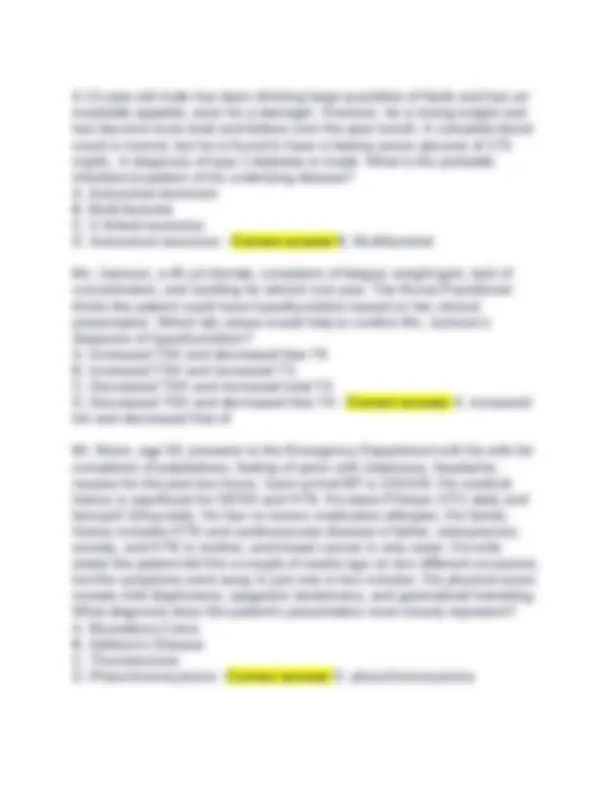
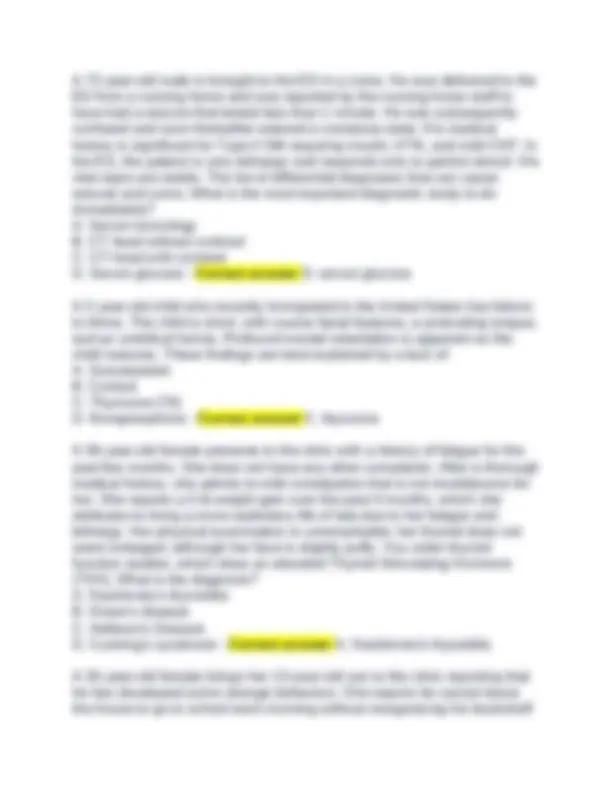
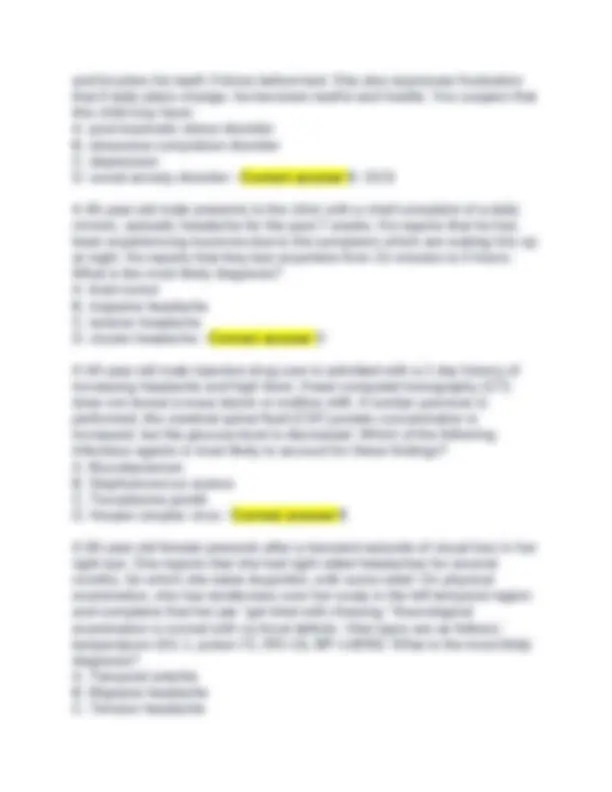
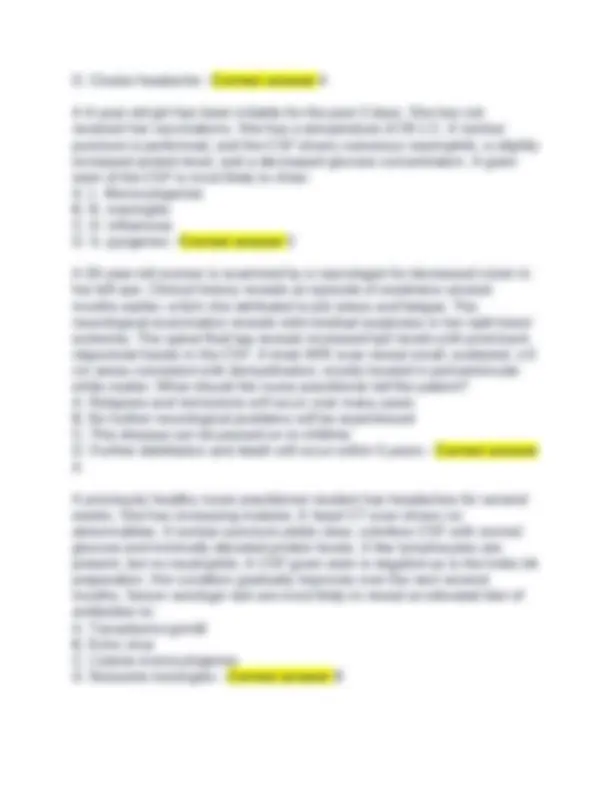
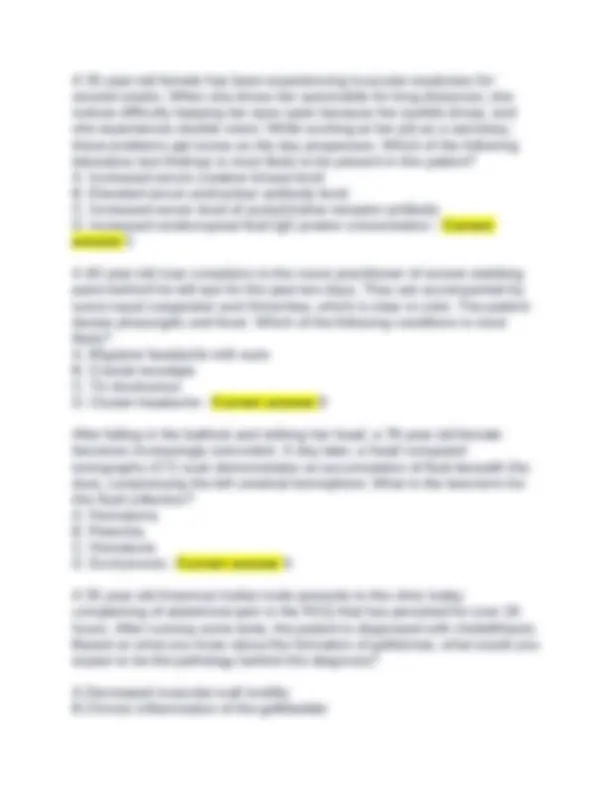
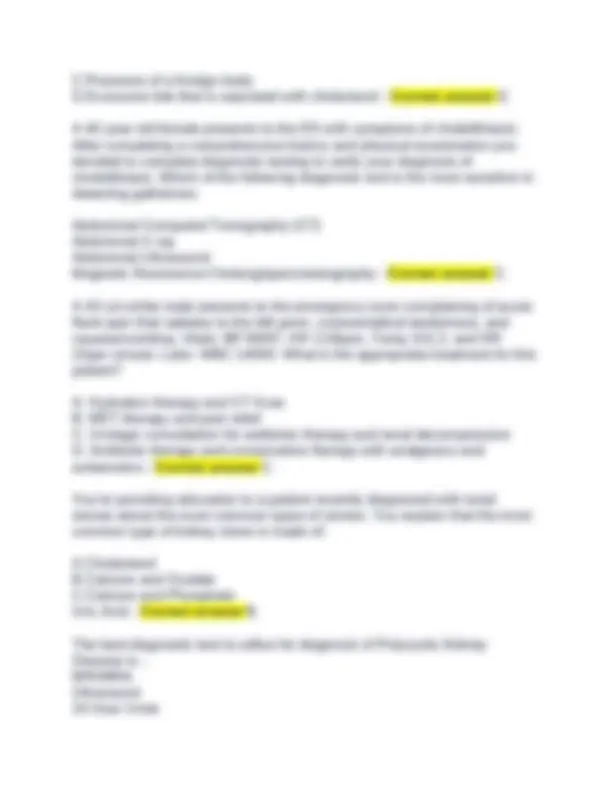
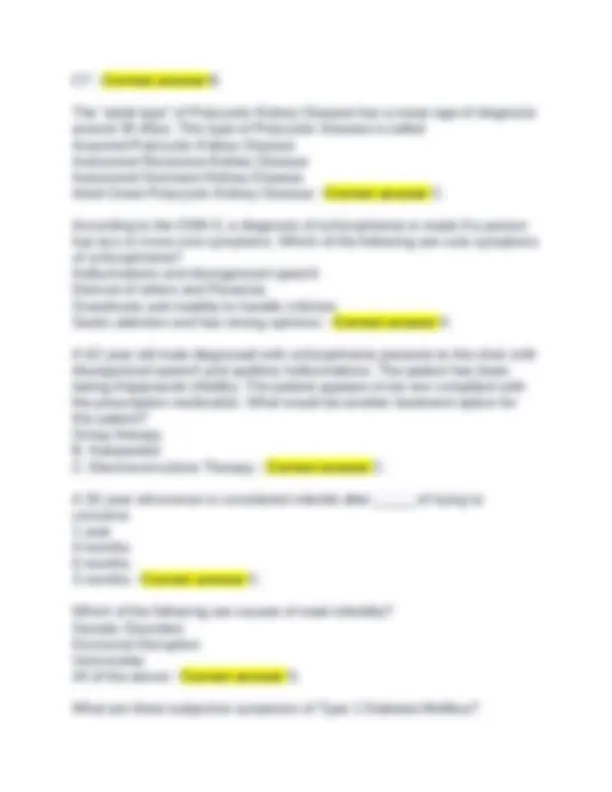
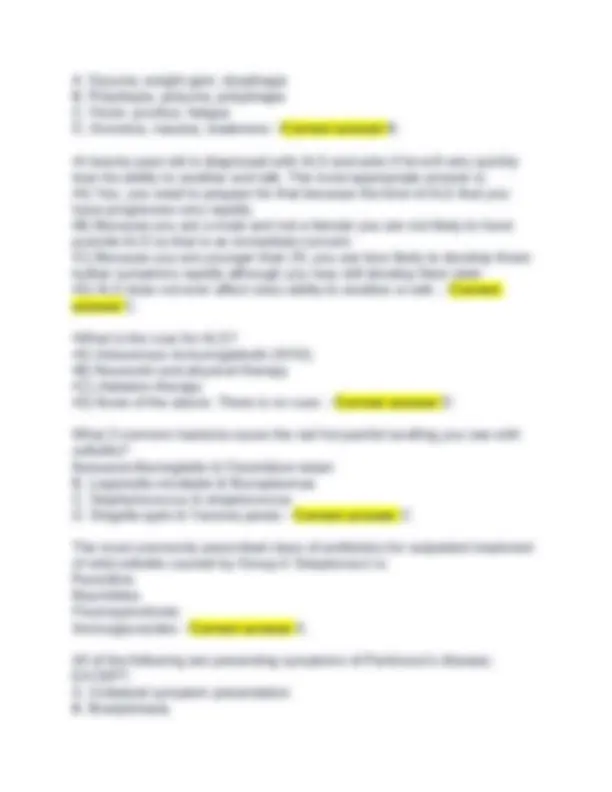
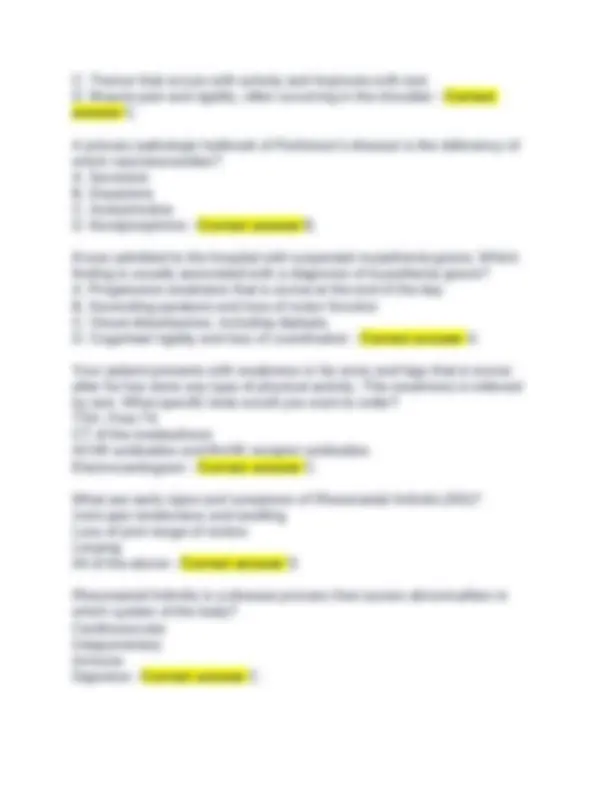
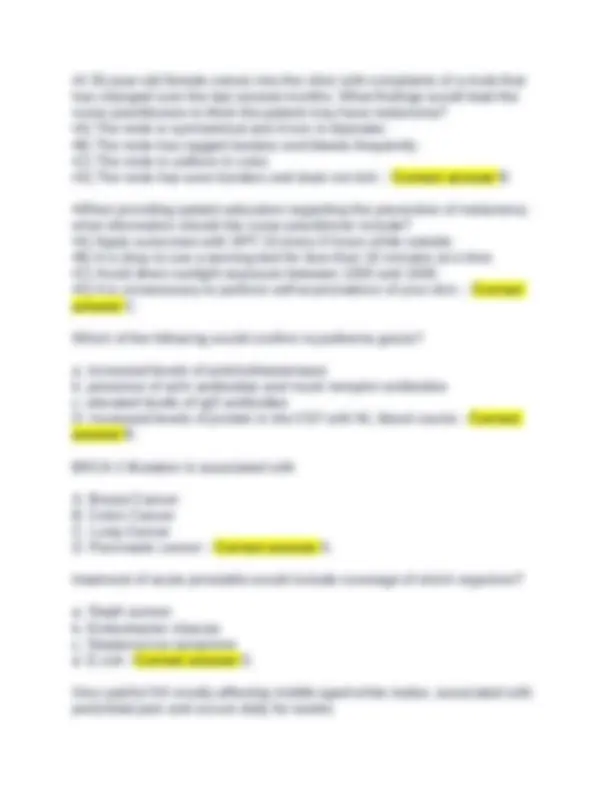
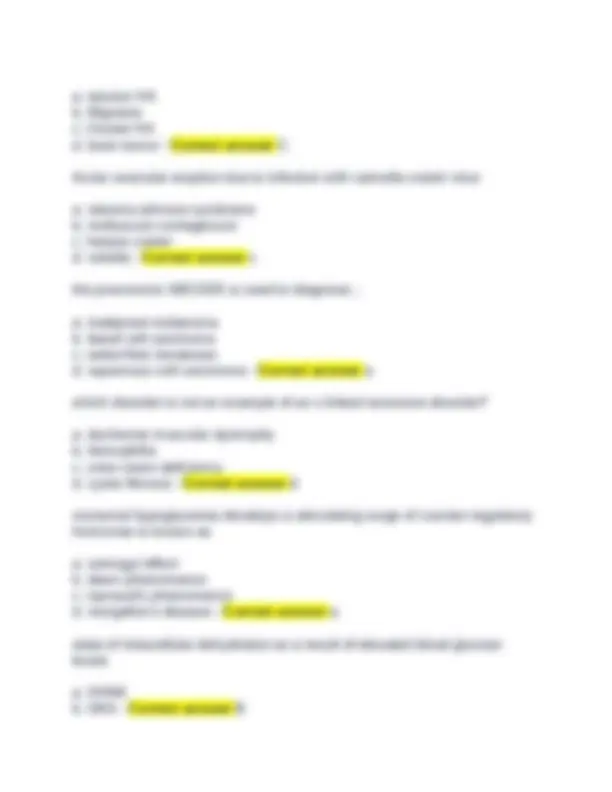
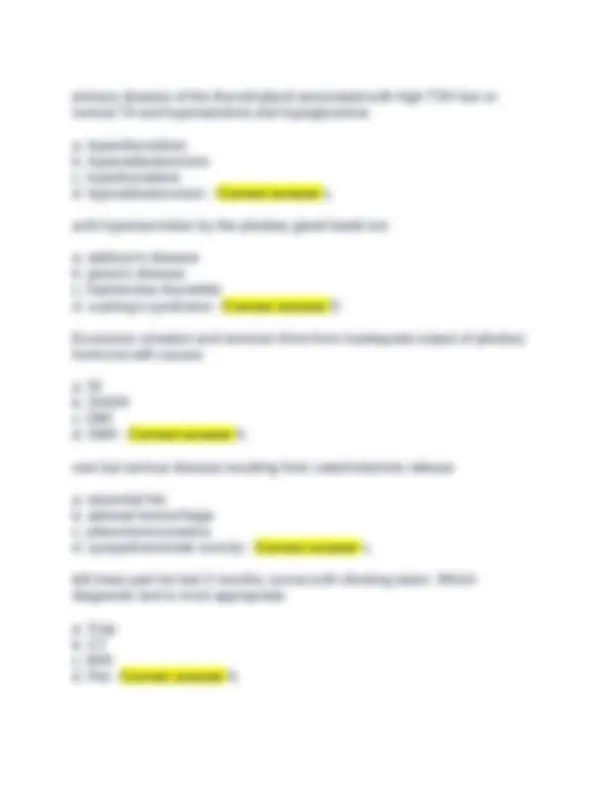
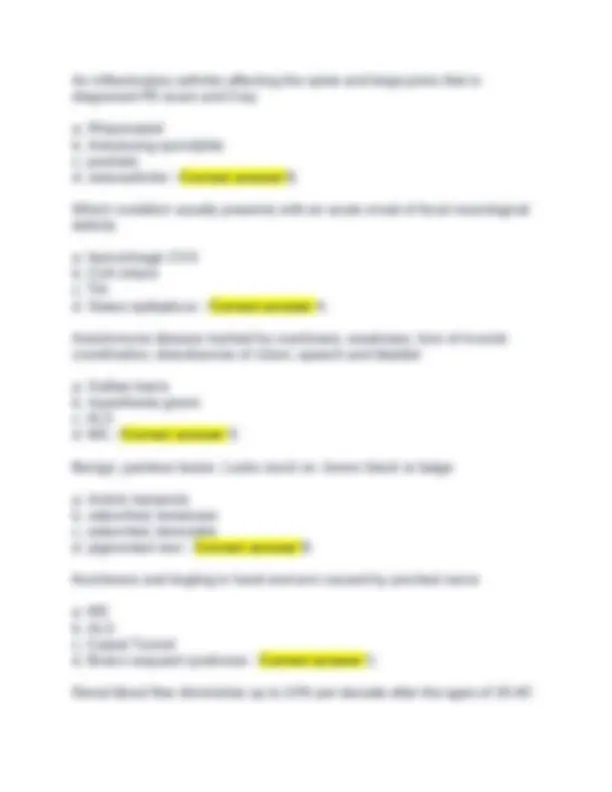



Study with the several resources on Docsity

Earn points by helping other students or get them with a premium plan


Prepare for your exams
Study with the several resources on Docsity

Earn points to download
Earn points by helping other students or get them with a premium plan
Community
Ask the community for help and clear up your study doubts
Discover the best universities in your country according to Docsity users
Free resources
Download our free guides on studying techniques, anxiety management strategies, and thesis advice from Docsity tutors
Advanced Pathophysiology Midterm Nur 6501 Walden University / Complete Actual Exam / 150+ Questions And Correct Detailed Answers / 2025/2026
Typology: Exams
1 / 32

This page cannot be seen from the preview
Don't miss anything!

























A 4-year-old child appears listless for the last week. He complains of pain when he is picked up by his mother, and he is irritable when touching his arms or legs. Several large ecchymotic lesions have appeared on his right thigh and left shoulder. A complete blood count reveals a HgB=10.2, Hct=30.5%, MCV=96fL, platelet count of 45,000/ML, and WBC count of 13,990/ML. Examination of the peripheral blood smear reveals numerous blasts. The blasts lack peroxidase-positive granules but do contain periodic acid-Schiff (PAS)-positive aggregates and stain positively for TdT. Flow cytometry shows the phenotype of blasts to be CD19+, CD3-, and sIg-. What is the most likely diagnosis? A. Acute lymphoblastic leukemia (ALL) B. Chronic lymphocytic leukemia (CLL) C. Acute myelogenous leukemia (AML) D. Chronic myelogenous leukemia (CML) - Correct answer Acute lymphblastic leukemia A 3-year-old child of Italian ancestry presents with failure to thrive. Physical examination indicates hepatosplenomegaly. His hemoglobin concentration is 6 g/dL, and the peripheral blood smear reveals severely hypochromic microcytic red cells. Total serum iron level is normal. The reticulocyte count is 10%. Hemoglobin electrophoresis shows very little hemoglobin A. A radiograph of the skull shows maxillofacial deformities. What is the principle cause of anemia and other abnormalities in this patient? A. Reduced synthesis of hemoglobin F B. Reduced red blood cell survival from imbalance in the production of alpha and beta globin chains C. Relative deficiency of vitamin B D. Increased fragility of the erythrocyte membrane - Correct answer Reduced synthesis of hemoglobin F
A 68-year-old previously healthy female has been feeling increasingly tired and weak for several months. She states that she has had black, tarry stools for several weeks. She is found to be anemic with a hemoglobin concentration of 9.3g/dL. The peripheral blood smear reveals microcytic and hypochromic blood cells. Which of the following conditions should be suspected as the most likely of her condition as indicated by the peripheral blood smear? A. Aplastic anemia B. Beta thalassemia C. Gastrointestinal blood loss D. Pernicious anemia - Correct answer Gastrointestinal blood loss A 76-year-old female notices that small, pinpoint to blotchy areas of superficial hemorrhage have appeared on her gums and on the skin of her arms and legs over several weeks. She is found to have a normal prothrombin time(PT) and partial thromboplastin time (PTT). Her CBC shows hemoglobin concentration of 12.7 g/dL, hematocrit of 37.2%. MCV of 80 fL/red cell, platelet count of 276,000/microliter, and WBC of 5600/microliter. Her template bleeding time is 3 minutes. Her fibrinogen level is normal, and there are no fibrin split products detectable. Which of the following conditions best explain these findings? A. Chronic renal failure B. Macronodular cirrhosis C. Vitamin B12 deficiency D. Vitamin C deficiency - Correct answer Vitamin C deficiency A young adult patient has just been diagnosed with Von Willebrand disease. Which of the following statements should you make to advise the patient of potential consequences of this disease? A. You may need an allogeneic bone marrow transplant B. You may have excessive bleeding following tooth extraction C. A splenectomy may be necessary to control the disease D. Expect increasing difficulties with joint mobility - Correct answer You may have excessive bleeding following tooth extraction
(CBC) demonstrates a hemoglobin concentration (HgB) of 13.2 g/dL, hematocrit (Hct) of 38.9%, mean cell volume (MCV) of 93 fL, platelet count of 175,000/microliter, and white blood cell (WBC) count of 1850/microliter, with the differential count showing 1 segmented neutrophil, 98 lymphocytes, and 1 monocyte per 100 WBCs. What is the most likely cause of these findings? A. Overwhelming bacterial infection B. Acute lymphocytic (or lymphoblastic) leukemia C. Acute myeloid leukemia D. Aplastic anemia - Correct answer Overwhelming bacterial infection A 31-year-old male has a history of chronic anemia and painful crises with joint and abdominal pain. A head computed tomography (CT) scan reveals several small remote infarctions. During one of these acute crises, he is admitted with severe dyspnea. A CBC is performed. Which of the following morphologic findings for RBCs is most likely to be seen on the peripheral blood smear? A. Tear drop cells B. Schistocytes C. Sickle cells D. Spherocytes - Correct answer Sickle cells A 50-year-old male has a blood pressure of 160/95 mm Hg. If this condition remains untreated for years, which of the following cardiovascular alterations will be seen on a transthoracic echocardiogram and ECG? A. Left Ventricular Hypertrophy B. Left Ventricular Atrophy C. Left Atrial Atrophy D. Right Ventricular Hypertrophy - Correct answer Left ventricular hypertrophy A 65-year-old male with longstanding uncontrolled HTN presents to the office for evaluation of syncope. His vital signs are temperature=98.3, Pulse=85, RR=17, BP=165/85. Physical examination reveals a fourth heart sound and a 4/6 crescendo-decrescendo murmur heard at the right upper sternal border with radiation to the carotid arteries. His ECG reveals
enlarged QRS waves, consistent with left ventricular hypertrophy. What is the most likely cause of his syncopal episodes? A. Mitral regurgitation B. Mitral Stenosis C. Aortic regurgitation D. Aortic stenosis - Correct answer Aortic stenosis A 63-year-old female presents to the emergency room with sudden onset of severe chest and back pain. She describes the pain as sharp and different from her anginal pain. Her past medical history is positive for HTN X 20 years. VS: HR 105, BP 160/105, RR 17. On physical examination, the NP notices that her pedal and radial pulses are not equal. What is the most likely cause of her chest pain? A. Unstable angina B. Aortic dissection C. Prinzmetal angina D. Acute myocardial infarction - Correct answer Aortic dissection A 45-year-old male collapsed suddenly while playing basketball. Bystander CPR and defibrillation was performed using an automatic external defibrillator or AED. When EMS arrived, the gentleman was awake and alert. The recorded rhythm strip on the AED shows tachycardia with AV dissociation (rate, approximately 220 bpm). Which arrhythmia induced his arrest? A. Nonsustained supraventricular tachycardia B. Sustained wide complex atrial tachycardia C. Wide complex ventricular tachycardia D. Narrow complex ventricular tachycardia - Correct answer Wide complex tachycardia A 44-year-old previously healthy male presents to the office complaining of increasing dyspnea on exertion and exercise intolerance over the last six months. The NP order a chest XRAY and transthoracic echocardiogram. The chest XRAY shows an enlarged heart and mild pulmonary edema. The echocardiogram reveals four-chamber cardiac dilation with an ejection fraction of 30% and mitral and tricuspid valve regurgitation. The patient is referred to the cardiologist who orders a CAT scan of the coronary arteries
D. Decreased central venous pressure - Correct answer Increased hydrostatic pressure The direction of blood flow and the clinical severity of symptoms in Tetralogy of Fallot is determined primarily by the: A. Presence of an atrial septal defect B. Diameter of the tricuspid valve C. Size of the left ventricle D. Degree of pulmonary stenosis - Correct answer Degree of Pulmonary stenosis A 36-year-old female presents to the ED with the chief complaint of acute SOB and anxiety that started suddenly 2 to 3 hours ago while she was working around the house. She denies chest pain. Her PMH is unremarkable. She takes oral contraceptives, but no other medications. Vital signs are temperature=99.1, RR=34, BP=148/90, pulse=100. Oxygen saturation is 94% on room air. Laboratory tests reveal WBC=7.1, Hgb=12.2, Hct=37.3, Na+=138, K+=4.7, Cl=109, HCO3=25, BUN=14, Cr=0.9, glucose=106. ABGs are obtained and reveal pH=7.52, HCO3=20, PaCO2=26, PaO2=70. CXR and ECG are normal. What type of acid base disorder does the patient suffer from? A. Respiratory alkalosis B. Respiratory acidosis C. Metabolic alkalosis D. Metabolic acidosis - Correct answer Respiratory alkalosis A 65-year-old male is brought for care by his wife because of headache, nausea, and fatigue. PMH is significant for small cell carcinoma of the lung diagnosed approximately 2 years ago. He also has a history of TIA (6 years ago) and mild CHF. Vital signs are as follow: temperature=99.8F, RR=18, BP=140/88, pulse=76. On examination, he is awake but somewhat lethargic. Physical examination is unremarkable. Laboratory tests reveal the following: WBC=8.3, Hgb/Hct=10.2/30.7, glucose=106, serum Na+= mEq/L, K+=4.3, BUN/Cr= 7.0/0.4. What is the most likely diagnosis? A. Syndrome of Inappropriate Anti-diuretic Hormone (SIADH) B. Diabetic ketoacidosis C. Diabetes Insipidus
D. Compensated diastolic congestive heart failure - Correct answer SIADH Leo is a 40-year-old male who presents to the clinic with complaints of shortness of breath while doing yard work. He states he has had worsening of the shortness of breath throughout the summer. He states when he was younger, he had shortness of breath and coughed a lot at night. He was given an inhaler for a few years, but he hasn't had any trouble since he was about nine years old. Which findings are most suggestive of a diagnosis of asthma? A. Dry cough during exam, respiratory rate of 20 breaths/minute, and wheezing upon auscultation of posterior lower lung lobes. B. Dry cough noted during the exam, Sp02=96%, FEV1 <80% predicted, and FEV1 increased 15% after administration of a short-acting bronchodilator. C. Bilateral wheezing noted on auscultation, Sp02=95%, and heart rate of 86 D. Pale, boggy nasal turbinates, dry cough, FEV1 <80% predicted and FEV1 increased 5% after administration of a short-acting broncho - Correct answer Dry cough noted during exam, Sp02=96%, FEV1 <80% predicted, and FEV1 increased 15% after administration of short acting bronchodilator. Which of the following symptoms is generally NOT considered a typical finding in someone with active tuberculosis infection? A. Weight loss B. Fever in the morning C. Night sweats D. Hemoptysis - Correct answer Fever in the morning A 43-year-old female presents to the clinic with a 2-day history of cough and fever. She states that she has felt tired for the past couple of weeks. Past medical history is unremarkable. On physical examination, she appears ill and has a persistent cough, productive of purulent sputum. She has crackles in her right posterior chest. BP=126/74, pulse=80, RR=24, temperature 102.2. WBC count is 14,000/mm3. What diagnostic test should be done first?
C. Pulmonary fibrosis D. Development of COPD - Correct answer Abscess formation A 66-year-old male is brought to the clinic with complaining of productive cough, fever, and chills for the past 2 days. The patient lives with his wife and is retired. PMH is significant for DM, for which he takes insulin; CHF, with an ejection fraction of 40%; and a history of renal insufficiency. He is alert and oriented. There is no history of smoking or alcohol use. On physical examination, he has crackles in the left lower lung. Cardiovascular examination is normal. Vital signs are temperature=103.3, BP=130/64, Pulse=128, RR=24. Oxygen saturation on room air is 97%. CXR shows infiltrates and consolidation in the left lower lobe of the lung. Laboratory test results show WBC=15, Hct=36, Na=142, glucose=167, BUN=36, Cr=1.5. What is the most likely diagnosis? A. Asthma B. Bronchitis C. Hospital acquired pneumonia D. Community acquired pneumonia - Correct answer Community acquired pneumonia A 70-year-old male has undergone an open cholecystectomy. Aggressive pulmonary toileting is necessary in the post-operative period because older adults have: A. Decreased residual capacity B. Increased vital capacity C. Increased alveolar surface area D. Decreased chest wall compliance - Correct answer Decreased chest wall compliance Which of the following elevated lab values on a CBC would indicate Macrocytosis? A. Mean corpuscular volume B. Mean corpuscular hemoglobin concentration C. Mean corpuscular hemoglobin D. red cell distribution width - Correct answer Mean corpuscular volume Which guidelines address the diagnosis and TX for COPD?
D. JNCC VIII - Correct answer GOLD When working up your pt for suspected restrictive lung disease, the most important part of the workup is what? A. Complete H&P B. IMAGING C. LABS - Correct answer Complete H&P ABG: pH 7.34, PCO2 59, PO2 86, HCO3 28, what is the likely diagnosis? A. Acute metabolic alkalosis B. Acute respiratory acidosis C. Chronic respiratory alkalosis D. Chronic respiratory acidosis - Correct answer Chronic respiratory acidosis A 40 yo pt presents with watery diarrhea and abdominal cramps, she took antibiotics for a UTI. What is the likely diagnosis? A. C-Diff B. Helicobacter pylori C. Escherichia coli D. Bacillus cereus - Correct answer C-diff Pulmonary fibrosis, aspiration, and bronchiostasis are examples of restrictive lung disease, which statement is true? A. prohibits air from flowing out of alveoli, trapping air in the lungs B. Prohibits air from flowing into the alveoli by not allowing chest expansion C. There is an increase in the compliance of lung tissue D. Lung volumes are increased - Correct answer Prohibits air from flowing into the alveoli by not allowing chest expansion Which of the following signs are associated with hypocalcemia?
B. Classic hodgkin's lymphoma lymphadenopathy non-hodgkin's lymphoma - Correct answer Non-classic hodgkin's lymphoma Which of the following steps in homeostasis is inhibited by aspirin? A. synthesis of von willebrand factor B. Activation of factor XA C. Aggregation of platelets D. Synthesis of antithrombin III - Correct answer Aggregation of platelets An elderly pt with a productive cough and fever is diagnosed with PNA, All of the organisms are capable of causing PNA except? A. Treponema pallidum B. Mycoplasma pneumonia C. Haemophlilus Influenza D. Streptococcus penumonia - Correct answer Treponema pallidum Acute bronchitis can usually be diagnosed by which of the following? A. White blood cell count B. Clinical presentation C. sputum culture D. Chest X-ray - Correct answer Clinical Presentation NP suspects Systemic lupus, which lab result would you expect to see? A. Hemoglobin 12. B. Leukocyte count of 8, C. Proteinurea and hematuria on UA D. Serum creatinine of 1.2 - Correct answer Proteinurea and hematuria on UA A 52 yo WM with hx of alcohol abuse presents to ED for hemataemesis. 2 L of blood loss 6 hours. A. Variceal bleeding from cirrhosis B. Bleeding peptic ulcer
C. Bleeding duodenal ulcer D. Mallory-weis tears - Correct answer Variceal bleeding from cirrhosis Pt has an MCV of 75. What type of anemia do they have? A. pernicious anemia B. Microcytic anemia C. Normocytic anemia D. Macrocytic anemia - Correct answer Microcytic anemia Pt presents with MCV of 86. What type of anemia do they have? A. Microcytic anemia B. Macrocytic anemia C. Normocytic anemia D. Pernicious Anemia - Correct answer Normocytic anemia Pt presents with an MCV of 106. What type of anemia do they have? A. Microcytic anemia B. Macrocytic anemia C. Pernicious anemia D. Normocytic anemia - Correct answer Mactocytic anemia What kind of patients are high risk for DIC? A. post-surgical patients B. Post bariatric surgery patients C. Post partum women D. All the Above - Correct answer All the above What are typical diagnostics used to diagnose an MI? - Correct answer EKG, Troponins and CPK True or False: Pt with unstable angina will have EKG changes - Correct answer false After further evaluation, you diagnose Alex with systemic lupus erythematosus. Which instruction would be included in the teaching plan for the patient?
A. All 4 chambers will be enlarged and dilated B. Only the lower chambers (ventricles) are enlarged. C. No chambers are affected in Cardiomyopathies. D. Only the upper chambers will enlarged. - Correct answer All 4 chambers will be enlarged and dilated A 59 y/o white male is seen at the ER. He presents with shortness of breath. Upon examination, the nurse practitioner notes crackles in lungs, a systolic murmur at the midclavicular 5th intercostal space, irregular heart rate, and decreased distal pulses. ECHO is performed, but appears normal. LVH is noted on EKG. What is the most likely diagnosis for this patient? A. Restrictive Cardiomyopathy B. Hypertrophic Cardiomyopathy C. pneumonia D. Dilated Cardiomyopathy - Correct answer Hypertrophic cardiomyopathy Which of the following predisposing risk factors are NOT associated with the formation of atrial fibrillation? A.Valvular heart disease B.Asian descent C.Mitral valve prolapse D. Hypertension - Correct answer Asian descent A patient presents to the emergency department complaining of chest pain, lightheadedness, and palpitations. After obtaining an EKG, it is discovered that the patient is in a rhythm known as atrial fibrillation. We know this is caused from... A.The upper chambers of the heart beating too quickly B.Abnormal electrical signals in the lower chambers of the heart C.Rapid chaotic atrial impulse formation causing ineffective quivering of the atria Quivering of the ventricles - Correct answer Rapid chaotic atrial impulse formation causing ineffective quivering of the atria
A 12-year-old boy is brought to the emergency room due to dyspnea. He has a known history of cystic fibrosis. What would be an expected finding in a person with this diagnosis on a chest x-ray? A. Hyperinflated lungs with bronchiectasis B. 3 cm cavity with an air-fluid level C. Bilateral infiltrates D. Pulmonary interstitial edema - Correct answer Hyperinflated lungs with bronchiectasis A sweat chloride test is ordered on a patient suspected of having cystic fibrosis. The result comes back as 21 mmol/L. What do these results indicate? A. The patient is positive for cystic fibrosis. B. The patient is positive for a CF metabolic syndrome. C. The patient is negative for cystic fibrosis. D. Further testing is needed to evaluate for cystic fibrosis. - Correct answer The patient is negative for cystic fibrosis Which of the following findings are NOT associated with cystic fibrosis? A. Meconium ileus B. Vitamin D deficiency C. Infertility D. Weight gain - Correct answer weight gain What is seen when diagnosing thrombolytic thrombocytopenia purpura? A. Headaches B. Neuro problems C. Schistocytes D. All of the above - Correct answer All of the above Mr. Wayne is a 42-year-old male who has hypertension and was recently diagnosed with mixed hyperlipidemia. He has been trying lifestyle changes for three months and his medications include lisinopril 10mg daily and one multivitamin daily. He comes into the office today to review his labs. His BP is 130/80, HR 90, BMI 34.8. His exam is unremarkable except for mild non- pitting edema to the ankles bilaterally. The nurse practitioner knows that, as
A 13-year-old male has been drinking large quantities of fluids and has an insatiable appetite, even for a teenager. However, he is losing weight and has become more tired and listless over the past month. A complete blood count is normal, but he is found to have a fasting serum glucose of 175 mg/dL. A diagnosis of type 1 diabetes is made. What is the probable inheritance pattern of his underlying disease? A. Autosomal dominant B. Multi-factorial C. X-linked recessive D. Autosomal recessive - Correct answer B. Multifactorial Ms. Jackson, a 45 y/o female, complains of fatigue, weight gain, lack of concentration, and swelling for almost one year. The Nurse Practitioner thinks the patient could have hypothyroidism based on her clinical presentation. Which lab values would help to confirm Ms. Jackson's diagnosis of hypothyroidism? A. Increased TSH and decreased free T B. Increased TSH and increased T C. Decreased TSH and increased total T D. Decreased TSH and decreased free T4 - Correct answer A. increased tsh and decreased free t Mr. Mann, age 50, presents to the Emergency Department with his wife for complaints of palpitations, feeling of panic with shakiness, headache, nausea for the past two hours. Upon arrival BP is 210/105. His medical history is significant for GERD and HTN. He takes Prilosec OTC daily and lisinopril 10mg daily. He has no known medication allergies. His family history includes HTN and cardiovascular disease in father, osteoporosis, anxiety, and HTN in mother, and breast cancer in only sister. His wife states the patient did this a couple of weeks ago on two different occasions, but the symptoms went away in just one or two minutes. His physical exam reveals mild diaphoresis, epigastric tenderness, and generalized trembling. What diagnosis does this patient's presentation most closely represent? A. Myxedema Coma B. Addison's Disease C. Thyrotoxicosis D. Pheochromocytoma - Correct answer D. pheochromocytoma
A 72-year-old male is brought to the ED in a coma. He was delivered to the ED from a nursing home and was reported by the nursing home staff to have had a seizure that lasted less than 1 minute. He was subsequently confused and soon thereafter entered a comatose state. His medical history is significant for Type II DM requiring insulin, HTN, and mild CHF. In the ED, the patient is very lethargic and responds only to painful stimuli. His vital signs are stable. The list of differential diagnoses that can cause seizure and coma. What is the most important diagnostic study to do immediately? A. Serum toxicology B. CT head without contrast C. CT head with contrast D. Serum glucose - Correct answer D. serum glucose A 2-year-old child who recently immigrated to the United States has failure to thrive. The child is short, with course facial features, a protruding tongue, and an umbilical hernia. Profound mental retardation is apparent as the child matures. These findings are best explained by a lack of: A. Somatostatin B. Cortisol C. Thyroxine (T4) D. Norepinephrine - Correct answer C. thyroxine A 36-year-old female presents to the clinic with a history of fatigue for the past few months. She does not have any other complaints. After a thorough medical history, she admits to mild constipation that is not troublesome for her. She reports a 5 lb weight gain over the past 6 months, which she attributes to living a more sedentary life of late due to her fatigue and lethargy. Her physical examination is unremarkable; her thyroid does not seem enlarged, although her face is slightly puffy. You order thyroid function studies, which show an elevated Thyroid Stimulating Hormone (TSH). What is the diagnosis? A. Hashimoto's thyroiditis B. Grave's disease C. Addison's Disease D. Cushing's syndrome - Correct answer A. Hashimoto's thyroiditis A 35-year-old female brings her 13-year-old son to the clinic reporting that he has developed some strange behaviors. She reports he cannot leave the house to go to school each morning without reorganizing his bookshelf